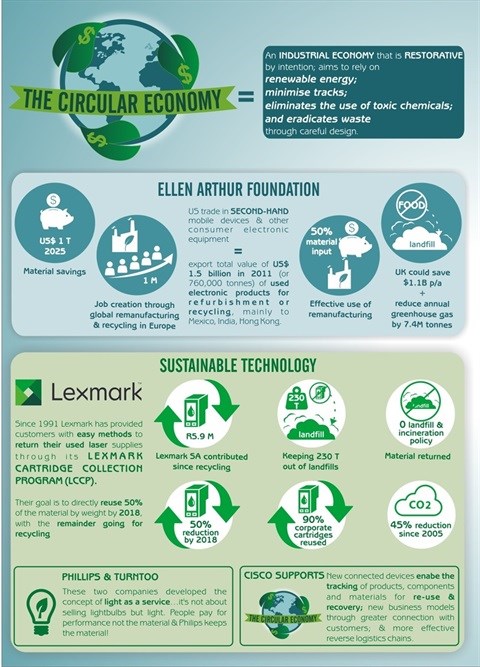The environmental benefits of the circular economy are well known. Its restorative values represent an opportunity for businesses to give something back - a chance to help alleviate our planet's emerging resource challenges through the re-use of materials. Many companies espouse the environmental virtues of 'going circular', yet neglect to mention that doing so can also result in significant benefits for both businesses and their customers.
A few leading-edge companies have already committed to the circular economy, identifying the need to contribute to environmental protection and the imperative of ensuring resource efficiency. Indeed, it was the mid-90s when we at Lexmark first sought to 'go circular', testing the use of post-consumer recycled (PCR) plastic content in one of our printer models. Move forward twenty years and the circular economy is not yet the ubiquitous policy many imagined it would be, with many companies still reluctant to join the circular community but maintain a traditional linear approach.
Implementing change
There are of course many reasons for this - each business is different and there are myriad difficulties in implementing such a change - however, we subscribe to the view that more companies would be willing to go circular if the benefits are more clearly established. Yes, it's good for the environment and yes, it's an efficient use of resources - but what else does it achieve? The sheer amount of red tape that needs navigating for most businesses means that very real benefits, both for them and their customers, must be clear. Thankfully, the circular economy offers such benefits in abundance.
While descriptions of the circular economy tend to focus on its holistic values, businesses and customers are also likely to see cost-savings as a result of its adoption. Through the re-use of resources and the economic boost that this can provide, companies will achieve a significantly lower net-spend on such materials. The effects of this will be welcomed by customers, with the costs of packaging materials for example reduced by recycling and reuse. Take the medium-lived products, (as opposed to short- or long-lived), as one example: according to the Ellen MacArthur Foundation (EMF) study "Towards the Circular Economy", circularity in manufacturing could yield net materials cost savings of up to $630bn per annum in the EU alone. This equates to 19-23% of current total input costs, or a recurrent 3-3.9% of 2010 EU GDP. Such savings are also reaching the customers, and represent a further economic incentive to go circular.
Future-proofing
Many businesses initially looked to the circular economy amidst growing concerns around resource scarcity. In doing so, these companies were not only addressing a growing environmental concern, but were helping to future-proof themselves against resource depletion and its impact on costs. With this in mind, it's key for such businesses not to think of the circular economy as a quick fix, but an opportunity to achieve long-term goals. It is vital, then, that a company looking to reap these benefits has a plan beyond going circular - they must look at how such a model will fit their own particular business issues and work with them to create value.
For Lexmark, the use of the recovered materials in our printer cartridges means less resource extraction, less additional processing and lower supply chain impacts. This, however, is not all. Our work in the circular economy has been informed by a long-term plan, with goals set and ambitious targets to achieve. Lexmark has set a double goal: one is to directly reuse 50% of cartridge material, by weight, by 2018, with the other ones meaning the remainder is recycled with the highest recovery rate possible to enable the use of secondary raw materials by other industries.
Quality preserved
While some of the benefits have been listed above, it's also key to acknowledge that we have seen no drop in quality with the products manufactured with PCR plastic content. Our cartridges are subject to the same quality tests and meet the same standards and warranty as those with all new components.
However, going circular results in more than just offering the same level of quality as new goods. The circular economy can also aid innovation, both in the way businesses deal with materials and in the products that land in the hands of customers. The EMF study, reports that innovative economies will see higher rates of business and product innovation, resulting in more profit opportunities for companies.
Economic stability
While going circular has paid dividends for us, its benefits can be more far-reaching than many realise. A research study undertaken by WRAP and The Green Party found that in the UK alone the resource efficiency ensured by the circular economy can result in greater economic stability, leading to new business and local employment opportunities. Indeed, this has meant that we can help not only our own customers, but extend a helping hand even further, with Lexmark's stated goal to regionally source 80% of its supplies in the European Union by 2017 driving the creation of jobs for the local economy.
Preserving the environment and going circular has enabled us to reduce our CO2 emissions by 45% globally since 2005 while improving product availability for customers. It's becoming increasingly difficult for companies to shy away from a model that represents such significant business and environmental benefits, while offering a chance to drive job creation. The long-term benefits will be significant, for us, our customers, the environment and the local economy, and it has become clear in our work that going circular is not only a commitment to something good, but an opportunity for very real, measurable business benefits.




































